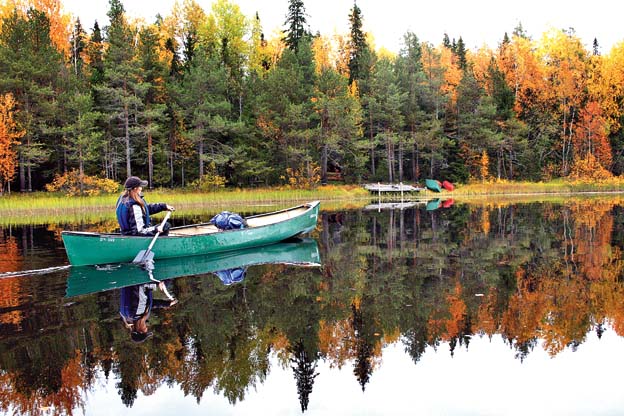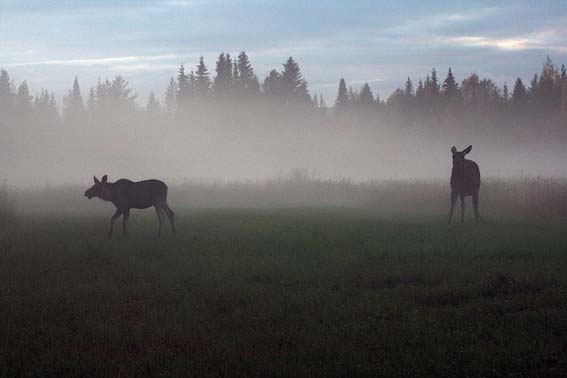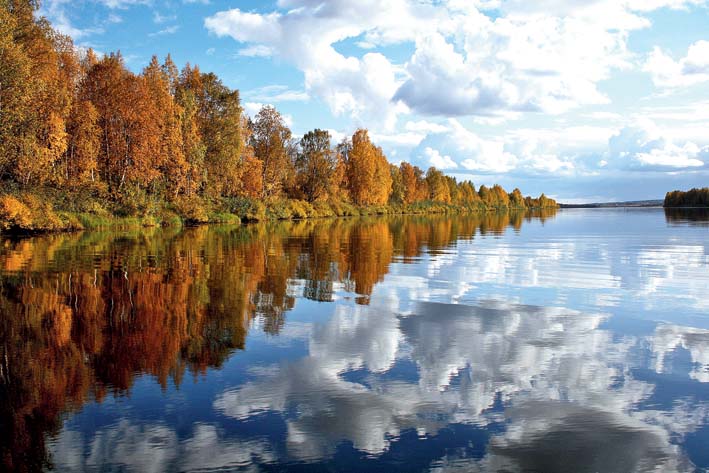Inside the overhead cupboard you will find a mineral water bottle, a comb, toothpaste and toothbrush, soap, a hand towel and, finally, an alarm clock and an electronic safe box, fixed to the wall.”
“What are these plastic cards for?” I feebly asked. “These are the most important items! One card is to enter the coupe and the other is for the washroom,” Antti Hakkinen replied. Seeing my totally flummoxed look, Antti, a college student, had very kindly come to my rescue. By then, I had started to have a panic attack since I have a mortal fear of being locked inside or outside my room or washroom.
In case you are wondering, this is not a description of a hotel room but that of an overnight train from Helsinki to Rovaniemi. I was visiting Helsinki University on an academic assignment and my host, Professor Chaichian, suggested that I utilise the long weekend I got visiting Rovaniemi, famous for the Santa Claus village and the most famous resident of the Arctic Circle.

The white line marking the Arctic Circle runs right through the Santa Claus hamlet Subir Ghosh
SUMMERTIME CAPITAL
Helsinki, capital of Finland and one of the most important cities of northern Europe, is charming to say the least. During summer, the sun reluctantly leaves the sky only for a couple of hours and the dwellers enjoy the long sunny days to the full. Everybody is outdoor-bound, be it hoisting the maypole and dancing around it, or dressing up for a pantomime in ancient aristocratic dresses, or visiting the open-air market for vegetables and a quick snack of fried fish in mayonnaise.
Helsinki ranks among the top five most liveable cities in the world. On the one hand it is very modern and technology savvy, while on the other it has a pleasant old world charm with clean air, peaceful parks, abundant greenery, beautiful statues and two iconic structures — the lavishly ornate red brick Eastern Orthodox Uspenski cathedral and the austere white Finnish Evangelical Lutheran Helsinki Cathedral.
The green and yellow streetcars, with pantograph and all inevitably reminded me of Calcutta.

The world famous Santa Claus Main Post Office also sells post cards and memorabilia of all sorts Subir Ghosh

Both the Uspenski Cathedral as well as the yellow-and-green streetcar are Helsinki icons Subir Ghosh
ON TO THE ARCTIC
At the end of the train journey, only a handful of passengers alighted at the final destination, Rovaniemi. The tiny and sleepy station immediately became empty and I managed to get hold of a taxi to take me to the city centre.
I had gotten used to the sparse population density of Finland but this was too empty even by those standards. Being a Saturday morning, this city was completely deserted. Armed with a printout map showing coordinates of the youth hostel where I had made reservations, I trudged along hauling my rucksack. On the way I made mental notes of the many travel agencies advertising short day trips, but, quite surprisingly, most were closed on Saturdays and Sundays whereas my tenure was for the weekend extending up to Monday night only.
I had a full canoeing and hiking programme already chalked out for Sunday and going to the Santa Claus village for Monday morning. However, I didn’t want to waste the full Saturday. After procuring my room keys I returned to the city centre and found one travel agency just opening and, as luck would have it, they had a place in a day trip for me that would consist of a boat ride to a reindeer farm. I also booked a night car safari to start at 10pm after I return from the day trip. I clearly understood the value of a 20-hour day!

A motor boat ride on the Kemijoki river offers awesome views Subir Ghosh
A LAP OF LAPLAND
Rovaniemi, situated a stone’s throw from the Arctic Circle, is the commercial centre of Finland’s northernmost province, Lapland. The rivers Kemijoki and its tributary Ounasjoki, flow past the city. Both Finnish and Swedish languages are spoken by its approximately 50,000 inhabitants.
Donning our bright orange life vests, a young couple and I boarded the motorboat as it cruised along the clear water of the Kemijoki, passing by quaint homes amid the lush greenery. Although it was summer the wind hitting us directly in the open boat was quite chilly and we had to zip up our windbreakers all the way. All around us was a riot of orange and reddish shades as the trees had already started dressing up in fall colours.
After about half-an-hour we reached our first stop, a small, privately-owned museum of local handicrafts and a workshop, run by Eino and Sofia Korhonen. The museum boasted of a nice and authentic collection of artifacts used by the indigenous Sami people — mainly traditional items such as woollen garments, reins for sledges pulled by huskies, saddles, wooden crockery and coffee mugs (I bought one), diverse things made from reindeer skin and antlers, knives, jewellery, intricate hanging patterns of thread as good luck charms, and shaman drums.
There were also peculiar-looking, human-shaped voodoo dolls. The glass windows were lined with lichen to keep the warmth inside. The other very important use of lichen we learnt a little later.
We entered the forest and came to a small opening and noticed a man in brightly coloured traditional clothing beckoning us to enter a narrow tent, typically that of a shaman. In ancient societies in the northern sub-Arctic forest zone, shamanism played an important part. The word shaman in Tungus language meant ‘one who knows’.
The shaman of a tribe was a man or a woman whose soul was supposedly capable of roaming freely outside the body in a state of trance. People believed that they could contact the spirits of the netherworld to gain information about say, healing a person, locating game and such like. The practice died out during the 17th century, most likely since they resisted Christianisation and the king’s authority.
We entered the tent and sat huddled in semi-darkness with a fire burning in the middle. The man claimed to be a direct descendant of Tietaja, a renowned shaman in Finnish culture. In the mystical ambience, with the mesmerising beat of a shaman drum, the man regaled us with supernatural stories. After coming out in to the bright sunlight each of us discovered a pair of satanic black horns on our foreheads!

Reindeer love lichen and will not let you go till they finish off the last one in your basket Subir Ghosh
REINDEER AND LICHEN
It was nearing lunchtime when we reached the reindeer farm run by Leo and Aino Makinen. Reindeer herding, one of the most important livelihoods of local people, is legally reserved for only Sami people in several north European countries.
Leo warned us to be careful about the antlers of the animals. For the uninitiated, antlers are sported by cervids, i.e., all deer, elk, moose and caribou (or reindeer). On the other hand the bovids, such as sheep, goats, cows, and bison, carry horns.
Antlers are made of bone that fall off every year in winter and a new set grows in time for mating season in the fall. These are smooth compared to the horns, that are pointed and sharp. Horns are made of keratin (same stuff as our fingernails) that grow throughout an animal’s entire life and never fall off.
Before entering the animal enclosure, each of us were handed a basket full of lichen, a delicacy for the reindeer. Aino advised us to feed the animals keeping our hands down lest they jump up and embrace us in order to reach it! As soon as we entered the paddock, each of us were surrounded by a pushing and jostling crowd of reindeer and were only released when our baskets were empty. We went inside the home of the Makinens where a sumptuous meal of bread, reindeer meat and home brewed wine were waiting for us. I felt a little awkward feasting on the meat immediately after playing with the poor animal’s cousins.

It takes a night safari to sight moose, which graze at night Subir Ghosh
FULL MOOSE NIGHT
After returning to my pad I had just enough time for a quick dinner before I heard a knock on my door at around 9PM. It was Elias Koskinen, my guide for the nocturnal adventure. It was pretty chilly as I thankfully slid into the heated car. Soon we left the city lights behind and moved into the forest area. The visibility was poor because of the mist. The main attraction was the possibility of seeing a wild moose as they come out to graze at night. The car drivers have to be extra careful because a collision can be dangerous for both the car and the moose.
The North American moose (or elk in Eurasia) is the largest and heaviest member of the deer family, the bulls weighing around 700 kg with an imposing height of about 1.4m-2.1m. Adult males have distinctive broad, palmate (open-hand shaped) antlers, that come in handy for getting chosen as a prospective mate while discouraging rival suitors. In fact, we were fortunate enough to catch sight of a shy young male and a mother and child duo.

The Konkaiden Polku trail hike involves covering a stretch of River Raudanjoki in a canoe Subir Ghosh
PANCAKE TRAIL
Early in the morning the next day Sofia Heikkinen, my guide for the nature trail hike, came to pick me up. In the car I was introduced to my fellow hiker, Lionel Benventano, a tour operator from Argentina. Lionel had come to test the waters for arranging tours in this area. Being surrounded by dense boreal forest of coniferous trees and small hills, Rovaniemi offered many scenic hiking trails suitable for different age groups and for people with different levels of physical strength and stamina. I had chosen the Konkaiden Polku trail, classified as a moderately difficult one.
After driving for an hour we reached the bank of River Raudanjoki, where two canoes were waiting for us. Luckily, Lionel was an experienced oarsman. So, Sofia led the way in her canoe and we followed. In our boat, I provided the muscle power while Lionel delivered the finesse. We had to cross the river against the flow. The canoe, being very narrow, would lurch perilously as soon as I turned sideways or back to get a better view for a photo. After a fair amount of huffing and puffing and without any mishap (the water was extremely cold!), we thankfully got back on terra firma and started our hike.
Surprisingly, there were many beware-of-mosquito billboards and some log huts were even decked with alarmingly large models of the pest. Sofia and Lionel applied some repellent creams, but being a proud Calcuttan I pooh-poohed the idea at once. Soon, we forgot our worries as the silent forest engulfed us. The route was slightly undulating and at times fitted with wooden planks, which, unfortunately, made it more slippery with the decomposed leaves on them. Although the weather was bright and sunny with an azure sky, it was very damp and moist in patches as parts of the trail often get submerged under water from melting snow.
Past the beautiful forest area and meadows we reached the famous Vikakongas Rapids. Only occasionally we met some people, tourist or otherwise, with wicker baskets, picking berries and mushrooms. A particular berry, known as cloud berry, often attracts bears close to the trail and can be alarming for humans, especially if the bear happens to be a female with cubs.
Finally we reached our destination, a small log cabin, equipped with an open-air chullah and stools, benches and a makeshift table, all made of logs. At last, I understood what Sofia was carrying in her hefty rucksack. Out came a frying pan, oil, a large amount of dough, jam and even a pot of honey. Expertly she lit a fire while we gathered small twigs and dry leaves to feed it.
Sofia quickly kneaded the dough and in no time was making pancakes while we hovered around with expectant plates in our hand! After having our fill, and sharing a few with another tourist couple, Lionel and I tried our hand at making pancakes. They were, of course, not entirely round and some got slightly burnt, but who cared anyway! After relaxing for about an hour, we gathered up our belongings and started the trudge back.
The return canoe ride was quite exciting. Since we were moving downstream, at times our canoes moved pretty fast. Relying on Lionel’s expertise, Sofia suggested that we go further down as far as the rapids since the ride would be too rough and dangerous beyond the rocks. Indeed, the bumpy ride over choppy waters was exhilarating, if slightly scary.

Hoisting the maypole and dancing around it is a summer ritual Subir Ghosh
DESTINATION: SANTA CLAUS
I was to take the train back the next evening and decided to utilise the full day by visiting the typically touristy Santa Claus village and doing the associated chore of jumping over the Arctic Circle. In the morning, I made the 10km bus journey to the small village. The area gets much more crowded and exciting in winter, when the entire region is covered in snow and offers sledge rides pulled by huskies and the tantalising possibility of seeing the Northern Lights.
The hamlet is built around the world famous Santa Claus Main Post Office, which gets about half-a-million letters addressed to Santa from children all over the world telling him what they want for Christmas. Inside, the post office is brightly lit and cheerfully decorated with smiling ladies dressed in Santa Claus-like red outfits and pointy elf hats. There is the ubiquitous souvenir store selling all kinds of curios and especially post cards. There are cosy sitting arrangements and writing tables for tourists who wish to send greetings to friends and relatives. A special attraction is the Arctic Circle postmark that is stamped on all despatches.
I came out to the bright sunshine and immediately noticed people jumping over the prominent white line painted across the centre of the village — the Arctic Circle. I also performed a customary broad jump over the line and headed off to board the bus for the return trip. What finally made my day was receiving a nice and authentic-looking certificate given by an agency that mentioned that I had successfully crossed the Arctic Circle!











